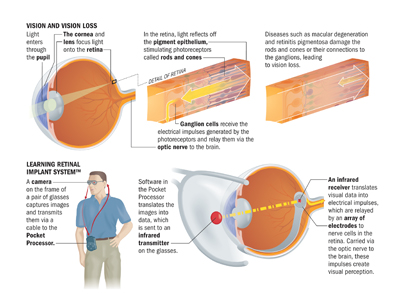Wireless transmission of data and energy let four patients who had no visual perception to see light and simple patterns, says Intelligent Medical Implants AG (IMI), of Zug, Switzerland.
The patients were implanted for up to 13 weeks with IMIs Learning Retinal Implant as part of a limited clinical study. The initial clinical indication for the system is for blind persons with retinitis pigmentosa.
 |
The system consists of three parts: the Retinal Stimulator implant, which is surgically placed in the patients eye; the Visual Interface, a pair of spectacles that contain an integrated mini-camera and wireless transmitter; and the Pocket Processor, a device that is worn at the patients waist and replaces the information processing function of the formally healthy retina. The digital signal processor allows the provision of intelligent information to the implant (and the nerve cells) by using tunable software to approximate the information processing normally carried out by the healthy retina.
Further clinical testing is planned, says Hans-Juergen Tiedtke, CEO of IIP-Technologies, a subsidiary of IMI. It is our expectation that, in the not-too-distant future, our Learning Retinal Implant System, along with rehabilitation, may allow patients to recognize objects by identifying their size, as well as their position, movements and shapes.

